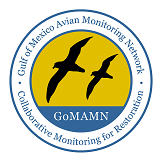The Gulf of Mexico Avian Monitoring Network (GoMAMN) was formed in 2014 to facilitate the collection and utilization of bird monitoring data to inform conservation and restoration decision making. GoMAMN is an ad-hoc, self-organized group of federal, state, academic and NGO scientists and managers representing the bird conservation community. Utilizing a suite of facilitated workshops and the principles of structured decision making, GoMAMN has: (1) established a forum to facilitate communication and coordination; and (2) identified and reached consensus on a set of core-values and data needs across a variety of stakeholders. Based on these discussions, the overarching goal is: maximize the utility of bird monitoring data to inform restoration and to advance bird-habitat conservation across the northern Gulf of Mexico. To that end, GoMAMN compiled and published a report entitled “Strategic Bird Monitoring Guidelines for the Northern Gulf of Mexico”. The Strategic Bird Monitoring Guidelines are advisory in nature and are intended to be a living-document and updated every five years to reflect our increased understanding and knowledge of how bird populations respond to conservation actions and underlying ecological processes.
To facilitate readability and application of the Strategic Bird Monitoring Guidelines, information is organized and presented in a series of topical, stand-alone chapters to include: stakeholder values, landbirds, marsh birds, raptors, seabirds, shorebirds, wading birds, waterfowl, avian health, and data integration. Each chapter provides an overview of threats, challenges, and uncertainties surrounding the conservation and management of 68 priority bird species, as well as recommendations to focus and guide the implementation of monitoring activities. An import note here, these Strategic Bird Monitoring Guidelines do not provide specific survey design and sampling protocols. Given the vast number of data needs across a variety of avian species and habitats, the development and presentation of species-specific survey designs and sampling protocols is beyond the scope of this report. Instead, the goal here is to identify key uncertainties and data needs that will facilitate increased communication and collaboration, not only within the bird community, but also across other resource groups.
The full report is 324 pages. Thus, each of the topical chapters is presented as a stand-alone PDF and accessible for download (See below). Further, an abridged version (e.g., Executive Summary) will be made available in the near future.
Suggested Citation
Wilson, R. R., A. M. V. Fournier, J. S. Gleason, J. E. Lyons, and M. S. Woodrey (Editors). 2019. Strategic Bird Monitoring Guidelines for the Northern Gulf of Mexico. Mississippi Agricultural and Forestry Experiment Station Research Bulletin 1228, Mississippi State University, Mississippi State, MS. USA. 324 Pages.
Downloads
Strategic Bird Monitoring Guidelines (Executive Summary)
Strategic Bird Monitoring Guidelines (Full Report)
Preface
Chapter 1 (Why Monitoring Guidelines?)
Chapter 2 (Stakeholder Values)
Chapter 3 (Landbirds)
Chapter 4 (Marshbirds)
Chapter 5 (Raptors)
Chapter 6 (Seabirds)
Chapter 7 (Shorebirds)
Chapter 8 (Wading Birds)
Chapter 9 (Waterfowl)
Chapter 10 (Avian Health)
Chapter 11 (Collaboration and Integration)
Chapter 12 (Concluding Remarks)

